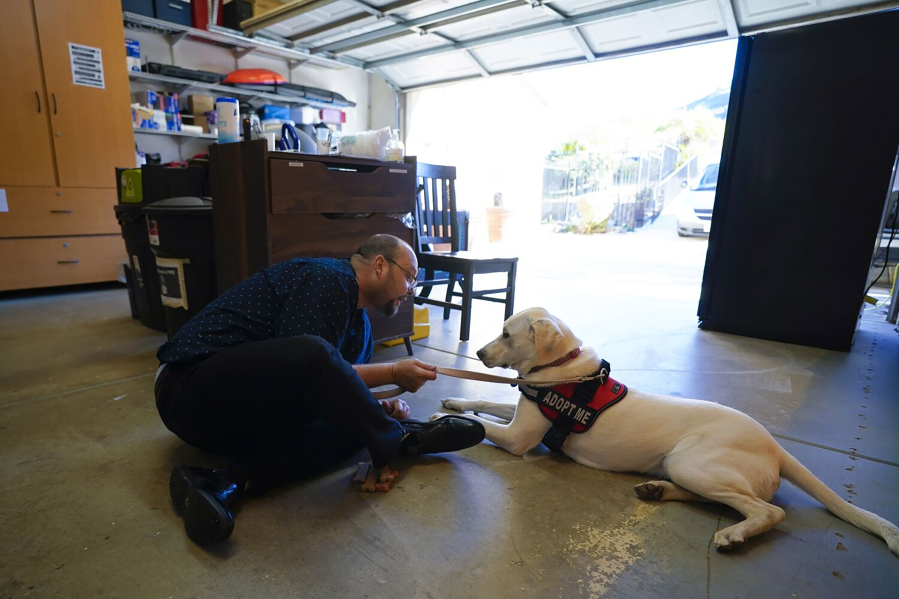ESCONDIDO, Calif. — Sure, Apollo’s sitting, shaking, leash walking and fetching skills have improved since he started living in a group home with four men with developmental disabilities.
But this 1-year-old Lab, as resident Adam Holwuttle explains, does his own kind of work, his presence and acceptance helping to smooth out the rough edges that can appear among housemates.
“Apollo helps me a lot like when we go on walks — my attitude, my anger, my frustration. He comes up to me, gives me kisses,” Holwuttle said, the dog’s head in his lap.
Kelly Bridges, who has lived at the spacious home in a quiet Escondido neighborhood since 2019, said Apollo’s willingness to shake or even dance around the room, standing up with paws in hands, is its own kind of positive feedback loop.
“I can rely on him to help me feel better, and he feels the same for me; I know it happens that way,” Bridges said. “You don’t have to be a certain kind of person to love a dog and be nice to a dog … because if you don’t love anybody or anyone, how can you love yourself?”
Apollo is this home’s fifth foster dog, provided under a strict agreement with Escondido’s Furballs Furever Rescue.
Operated by Merakey, a not-for-profit developmental and behavioral health services company that runs nearly 600 group homes in five states, the Escondido location is its first to participate in such an arrangement.
Some might find that fact surprising, as dogs and other animals have been embraced pretty much everywhere in health care. These days, therapy dogs roam the halls of hospitals, cancer units and nursing homes, helping people with anxiety and loneliness.
But group homes, especially those where residents may be prone to outbursts and even minor violence due to neurological conditions, have not generally been on the therapy dog circuit, let alone considered as suitable foster homes for dogs such as Apollo, whose previous family surrendered him once he started chewing furniture, having indoor accidents and refusing to go into his kennel.
Dog safety guaranteed
AnnMarie Stanton, director and program lead for this particular residence in Escondido, said there were quite a few nos before Furballs Furever said yes.
“We had to jump through hoop after hoop to get this started. Everybody said, ‘These guys can’t do it; they might get violent and cause trauma to the dogs,’” Stanton said. “But the animals have what we call a safetynet crisis plan where we guarantee, in the event of a behavior, the dog immediately goes to his kennel or behind a locked door.”
That rule has been used only once so far across five dog fosterings, and it remains a powerful governor of behavior, Stanton said.
“If somebody is upset and they’re starting to raise their voice, the others will say, ‘Hey, you’re scaring the dog. Bring it down. You can be mad, but go in your room and close the door. We’re not going to scare the dog,’” Stanton said.
That ability to limit outbursts has had very measurable results.
Of Merakey’s four group homes in San Diego County, the only one with a dog also has the lowest rates of property damage.
Dogs, the company has found, also serve as useful disruptors, their needs for walks, playtime and feeding breaking into the often-rigid schedules of those who live on the autism spectrum.
To eventually move to less-restrictive residences, clients must learn to deal with disruption and interruption, and nothing snaps a comfortable routine like a dog that must be let out to do its business.
But it goes much deeper than that. Dogs and other animals provide the thing that every person needs at the core of their being: a purpose.
“The animals need them. They need their love and affection; they need them to get a bath; they need them to go out on walks. They need them, and to feel needed and wanted is huge in this community,” Stanton said.
Agreeing to work with Merakey on the project was a leap of faith for Furballs Furever Rescue, which has been up and running in Escondido for only three years. Founder Katherine Chilidonia said she had experience working in group homes for children and, talking with Stanton, could see how residents could benefit.
So far, all four of the dogs that the group of men fostered before Apollo have been adopted and not returned to the rescue.
Part of that success, Chilidonia said, comes down to the dogs and the people being able to relate to each other. Both, after all, have struggled to fit into the footprint of society’s expectations.
Merakey has been watching the program closely and plans to use it to add animals to other group homes it operates.
Elise Tretola, a senior vice president for the company, said the San Diego Regional Center, which supports 4,000 residents with developmental disabilities in San Diego and Imperial counties, and the California Department of Developmental Services have been willing to support the unprecedented initiative.
“We just don’t get this kind of opportunity in other states where we operate,” Tretola said. “Now that we have a model and we have results, we think that we have an opportunity to go back to some states and say, ‘Look what we’ve done here. Can we get a similar kind of partnership?’”




